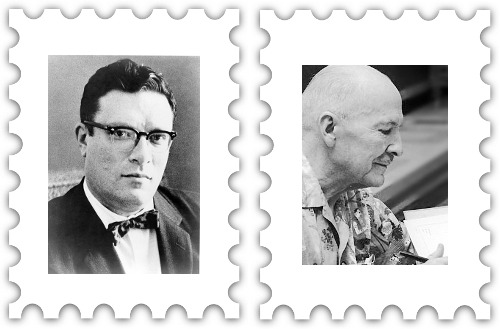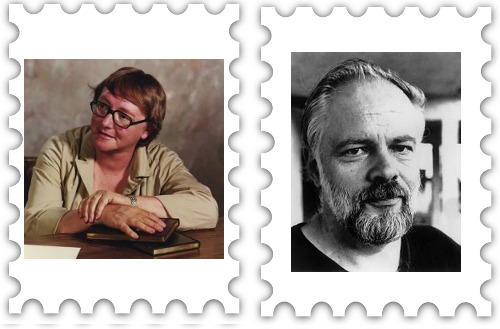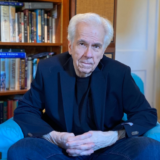Sometime after John W. Campbell died in 1971, a few science fiction fans launched a campaign requesting that the U.S. Postal Service issue a postage stamp commemorating the legendary editor of Astounding Science Fiction and Analog.
I recall eagerly signing a petition for the stamp while a member of the Wayne Third Foundation, the SF club at Wayne State University in Detroit. There was no question Campbell was a seminal figure in American science fiction, having ushered in the genre’s Golden Age by nurturing the writing careers of Robert A. Heinlein, Isaac Asimov and a host of other still-beloved authors.
It was, of course, a fool’s errand. The general public at the time still dismissed science fiction as “that Buck Rogers stuff.” “Star Trek” had come and gone on network television with barely a ripple, and “Star Wars” was still years in the future. Most folks then thought science fiction was the province of children, the mentally unbalanced and the socially unskilled.
How times change. My heart couldn’t help skipping a beat a couple of weeks ago when Linn’s Stamp News — the New York Times of stamp collectors — published a roundup story about upcoming stamps. With little elaboration, the story mentioned that a set of stamps featuring science fiction writers was on the USPS schedule this year.
No names were given, but the article said the stamps would appear in a “multiple configuration.” That’s a fancy way of saying several different stamps would be printed on the same sheet. The most common configuration of such issues is four stamp designs on a 20-stamp sheetlet.
Now the question arises: Which authors will get a shot at philatelic immortality?
Heinlein and Asimov would seem to be no-brainers; their work is as popular now as when they were alive. Few would complain if Arthur C. Clarke were included … but he’s a Brit. Likewise, Ray Bradbury would be a perfect fit, but he passed away only last June. Under USPS rules, a person must be dead at least five years before being eligible for stamphood.
 If current popularity is a factor — and the Postal Service likes to issue stamps that people collect instead of use, thus scoring a tidy profit — Philip K. Dick would be a shoo-in based on the hit movies inspired by his writings (“Blade Runner,” “Total Recall,” “Minority Report,” etc.). Forget about his drug use; modern stamps U.S. stamps have featured some people who abused far worse drugs than Dick ever did. And the fact that his childhood stamp collection was one of his prized possessions is sure to be worth some extra points.
If current popularity is a factor — and the Postal Service likes to issue stamps that people collect instead of use, thus scoring a tidy profit — Philip K. Dick would be a shoo-in based on the hit movies inspired by his writings (“Blade Runner,” “Total Recall,” “Minority Report,” etc.). Forget about his drug use; modern stamps U.S. stamps have featured some people who abused far worse drugs than Dick ever did. And the fact that his childhood stamp collection was one of his prized possessions is sure to be worth some extra points.
So that’s three reasonable choices. But what about Number Four? Campbell? No arguments here. Another logical candidate is Hugo Gernsback, the immigrant from Luxembourg who became the Father of America Science Fiction by bringing “scientifiction” to the nation’s newsstands via Amazing Stories in 1926.
 But … the Postal Service has been big on inclusivity for decades and undoubtedly would prefer to go beyond four dead white guys for the set.
But … the Postal Service has been big on inclusivity for decades and undoubtedly would prefer to go beyond four dead white guys for the set.
Scores of women have achieved great success in SF since the 1960s and have changed the field tremendously. The era when science fiction was a boys club is long gone and never will return. Unfortunately for the purposes of this story (but luckily for the female stars and their fans), most are still alive and productive.
Still, a couple of old-timers would fit right in with the best of the male Golden Agers. C.L. (Catherine Lucille) Moore, the wife and often collaborator of Henry Kuttner, had a terrific career from the early 1930s into the late ‘50s. The creator of two beloved series characters, Northwest Smith and Jirel of Joiry, Moore drew acclaim from legions of fans who had no idea she was a woman. She reportedly was slated to be the first woman to receive the Science Fiction and Fantasy Writers of America’s Grand Master Award until her second husband asked that the honor be withdrawn due to Moore’s poor health.
 Another strong possibility is Leigh Brackett, the wife of old pro Edmond Hamilton, who established herself as a master of the space opera in the 1940s and ‘50s. Among her better-known novels are “The Sword of Rhiannon” and “The Long Tomorrow.” In her spare time, she knocked off screenplays for such classic films as “The Big Sleep,” “Rio Bravo” and “The Long Goodbye.” She also wrote (and received screen credit for) the screenplay for “The Empire Strikes Back.” Industry sources, however, say George Lucas used none of her work in the film.
Another strong possibility is Leigh Brackett, the wife of old pro Edmond Hamilton, who established herself as a master of the space opera in the 1940s and ‘50s. Among her better-known novels are “The Sword of Rhiannon” and “The Long Tomorrow.” In her spare time, she knocked off screenplays for such classic films as “The Big Sleep,” “Rio Bravo” and “The Long Goodbye.” She also wrote (and received screen credit for) the screenplay for “The Empire Strikes Back.” Industry sources, however, say George Lucas used none of her work in the film.
Two other solid candidates are Marion Zimmer Bradley and anthologist Judith Merrill. While her forte was fantasy more than science fiction, especially “The Mists of Avalon,” Bradley is renowned as the creator of the Darkover series and was a co-founder of the Society for Creative Anachronism. Merrill began as a writer but became highly influential as an editor. Her annual “Year’s Greatest Science Fiction and Fantasy” collections of short stories and novelettes were a must-read for fans, and she led the drive to raise SF’s literary values through the New Wave revolution in the 1960s.
 Well, that’s the start of a list, but many more options exist. For all we know, the stamp honorees were chosen by a mummified member of First Fandom, so the set will feature A. Hyatt Verrill, Ralph Milne Farley and eccentric editor/publisher Ray Palmer, who brought the world the “Shaver Mystery.” (Don’t ask)
Well, that’s the start of a list, but many more options exist. For all we know, the stamp honorees were chosen by a mummified member of First Fandom, so the set will feature A. Hyatt Verrill, Ralph Milne Farley and eccentric editor/publisher Ray Palmer, who brought the world the “Shaver Mystery.” (Don’t ask)
One person definitely won’t be included: Edgar Rice Burroughs, the man behind Tarzan, Barsoom and Pellucidar. He won philatelic immortality with a commemorative stamp in 2012, the centenary of both “Tarzan of the Apes” and “A Princess of Mars.”
So who do you think deserves to be part of the stamp set? Send in your ideas, suggestions and criticism, and let the dialogue — or old-fashioned brouhaha — begin.











I’d like to suggest Kurt Vonnegut, Jr. Even though he didn’t appreciate being pigeonholed as a science fiction writer he certainly made use of aliens, time travel and alternate realities in his stories. Roger Zelazny comes to mind, though he hasn’t held up as well in modern times. Octavia Butler for sure, Andre Norton, Marion Zimmer Bradley, Leigh Brackett and C. L. Moore, to hold up the distaff side of things.
Great suggestion, Tom, though I think Vonnegut has a high-enough mainstream profile and reputation to qualify for a single-issue stamp. It would be unfair to all parties to include a writer of his stature with beloved hard-core SF writers like Heinlein and Asimov.
Please see my recent post with updated information on the SF writers stamps, which not only names (allegedly) the authors to be honored but also includes the sad news that the issue will not appear this year.
What recent post? Where? And are any of them going to be women?
And hey, how about Teddy the Fish?
Nope, no women, but I can’t argue that any of the five picked are unworthy. Here is Gene’s recent post:
https://amazingstories.com/2013/07/liftoff-scratched-for-sf-authors-stamps/
Rather than going for more dead white men, it would be nice to see Octavia Butler on a stamp. She was one of SF's most distinctive voices, and books like Kindred and Wild Seed show SF dealing elegantly and passionately with real world problems. I'd like to see Samuel Delany on a stamp one day as well, but as he's still alive I'd prefer him to stay that way. If we wait until July, Thomas M. Disch will have been dead 5 years.
I didn't know this until just now, but apparently in 2011 the Postal Service abandoned its rule against depicting living persons on stamps, and honoring living writers was cited as one of their specific reasons for doing so. Story here: https://usatoday30.usatoday.com/news/washington/st…
So Le Guin could certainly be one of the choices, and the fact that Bradbury has been dead less than five years wouldn't be an obstacle.
Patrick, it's highly unlikely the Postal Service will honor a living person on a stamp anytime soon. The policy change, which made headlines in 2011, was based on a rather dubious legal loophole uncovered by a bureaucrat, not a change in federal law. (I with I could remember the particulars, but it struck me as rather fishy at the time.)
The five-years rule, which was adopted a few years ago, essentially remains in effect. (The previous policy stated that all persons except former presidents had to be dead for 10 years before being considered for a stamp.)
As I mentioned in a previous comment, John Glenn would have the perfect choice for initiating the new policy in 2012, the 50th anniversary of his orbital flight. (An aside: it was a John Glenn stamp issued by Hungary in 1962 that brought me into stamp collecting.)
Ursula K. Le Guin is one of science fiction's all-time greats and deserves to appear on a stamp someday. But if death remains a requirement for stamphood, I hope that day is far, far away.
UPDATE: According to the March 4 issue of Linn's Stamp News, the science fiction writers stamp issue will honor FIVE authors, not four as originally expected. There's no clue yet about which authors will appear on the stamps.
So who would YOU like to see on a postage stamp?
Alice Sheldon perhaps, but it is so hard to choose.
Incidentally, the post office did away with the five years dead rule recently, but to the best of my knowledge they haven't gotten to a live person yet.
One concern about featuring living people is the case of Lance Armstrong who, at the time the rule change was announced (late 2011), was widely discussed as a strong candidate to be one of the first living persons to be featured on a US stamp, and we all know how that turned out. There was an ancient Greek, I can’t recall which one, who said something along the lines that you can’t be considered to have led a good life until you are dead. O. J. Simpson stamp anyone?
Excellent point, David. The USPS announced its decision to honor living people on stamps with great fanfare in 2011, but there's been plenty of backtracking behind the scenes ever since. While the change hasn't officially been withdrawn, the Postal Service can't pull the trigger. Let's face it, the ideal moment for such a stamp came last year with the 50th anniversary of John Glenn being the first American to orbit the Earth. While Glenn was a so-so senator, his career in the military and as an astronaut made him an excellent candidate for stamphood.
Meanwhile, I did consider adding the great Alice Sheldon to my story, but I felt the USPS would have been conflicted by a stamp depicting a woman identified as James Tiptree Jr. Too much confusion for the non-fen.
Ursula K. Leguin or ,my preference Andre Norton